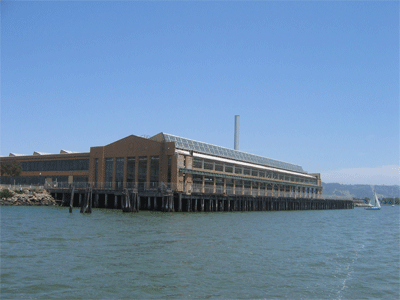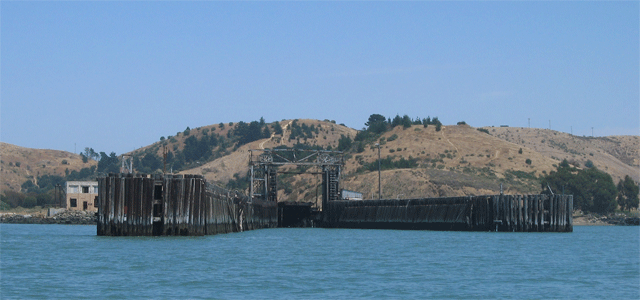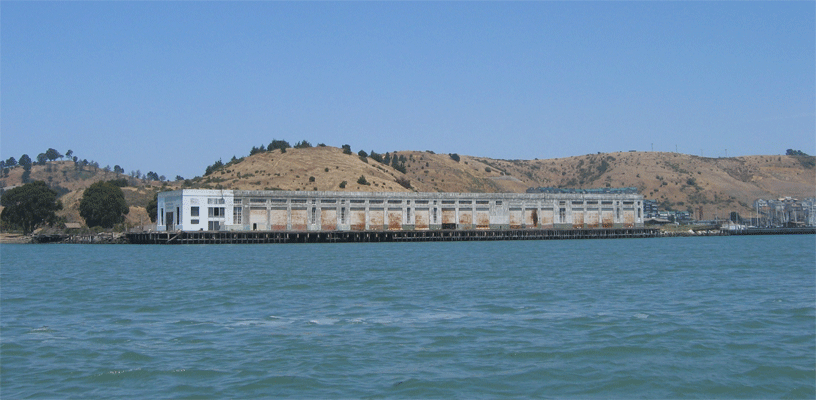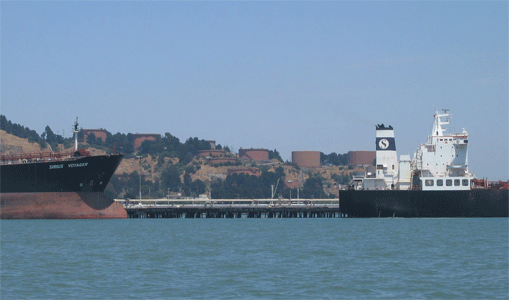|
|
 Ellis Landing, Richmond's first maritime facility was established in 1860 at the foot of what is now Harbour Way (at the left side of this picture). It operated for more than 40 years until the beginning of the 20th century. Sailing scows carried farm produce to San Francisco and ferried passengers back and forth across the Bay, but only when the tide was high enough to navigate through the mudflats. In 1930, during the Great Depression, the Ford assembly plant was built measuring nearly 500,000 square feet and making Ford the third largest employer in the City of Richmond. During WWII, he Richmond Ford Assembly Plant switched to assembling jeeps and to putting the finishing touches on tanks, half-tracked armored personnel carriers, armored cars and other military vehicles destined for the Pacific Theater. By July of 1942, military combat vehicles began flowing into the Richmond Ford plant to get final processing before being transported out the deep-water channel to the war zones. After the war, production of Fords resumed at the plant somewhat offsetting the sudden job loss caused by the cessation of ship production. The last Ford was assembled in February 1953, with the plant
being closed in 1956. Most of the damage you see to the building was caused by the Loma Prieta Earthquake of 1986. For a while after that earthquake, a passanger ferry operated this location .The Ford building was used in the filming of the movie "Tucker". Ellis Landing, Richmond's first maritime facility was established in 1860 at the foot of what is now Harbour Way (at the left side of this picture). It operated for more than 40 years until the beginning of the 20th century. Sailing scows carried farm produce to San Francisco and ferried passengers back and forth across the Bay, but only when the tide was high enough to navigate through the mudflats. In 1930, during the Great Depression, the Ford assembly plant was built measuring nearly 500,000 square feet and making Ford the third largest employer in the City of Richmond. During WWII, he Richmond Ford Assembly Plant switched to assembling jeeps and to putting the finishing touches on tanks, half-tracked armored personnel carriers, armored cars and other military vehicles destined for the Pacific Theater. By July of 1942, military combat vehicles began flowing into the Richmond Ford plant to get final processing before being transported out the deep-water channel to the war zones. After the war, production of Fords resumed at the plant somewhat offsetting the sudden job loss caused by the cessation of ship production. The last Ford was assembled in February 1953, with the plant
being closed in 1956. Most of the damage you see to the building was caused by the Loma Prieta Earthquake of 1986. For a while after that earthquake, a passanger ferry operated this location .The Ford building was used in the filming of the movie "Tucker".
 In 1899 Richmond attracted the Santa Fe Railroad Company (its first industry) largely on the basis of the claim that Point Richmond (then an island) was "the only point on the east side of the Bay where land and navigable deep water meet.” Santa Fe Railroad established its western terminus in Point Richmond. On July 3, 1900, the ferry “Ocean Wave” discharged the first passengers at Point Richmond’s Ferry Point to a waiting Chicago-bound train. Later on, the railway cars were loaded directly ontto barges for the last leg of the trip to San Francisco. The building of the bridges killed off the ferry traffic all over the bay and the rise of the container ship (which requires vast amounts of space to hold the containers) put an end to the dominance of the Port of San Francisco In 1899 Richmond attracted the Santa Fe Railroad Company (its first industry) largely on the basis of the claim that Point Richmond (then an island) was "the only point on the east side of the Bay where land and navigable deep water meet.” Santa Fe Railroad established its western terminus in Point Richmond. On July 3, 1900, the ferry “Ocean Wave” discharged the first passengers at Point Richmond’s Ferry Point to a waiting Chicago-bound train. Later on, the railway cars were loaded directly ontto barges for the last leg of the trip to San Francisco. The building of the bridges killed off the ferry traffic all over the bay and the rise of the container ship (which requires vast amounts of space to hold the containers) put an end to the dominance of the Port of San Francisco

Terminal One, located near Point Richmond, operated as a port facility from the early 1900s until the late 1980s. It was primarily used as a storage and warehouse facility and for transfer of cargo and bulk liquids from ships to trucks and rail cars. This location had no room to store the bulky containers and poor access for trucks and trains and so fell into disuse with the advent of containerized shipping. There is still some break bulk shipping in and out of Richmond primarily of scrap metal and some chemicals. Two container cranes stand just around the bend at Portrero Reach. The largest shipping operation appears to be shipment of cars which are transfered to trains here.
 From a Southern Pacific train one day in October 1901 stepped W.S. Rheem and two other Standard Oil officials. They drove a horse and buggy to a tract the company had purchased just north of Point Richmond. Before sundown, Rheem had hired men to clear the land, and within eight months the largest refinery on the Pacific Coast was in operation. In 1902, the refinery produced nearly 10,000 barrels of petroleum products. Its wharf, refinery and storage and research facilities are still in operation under the trust-busted fragment known as Chevron..Chevron remains the city's largest employer and the Chevron Long Warf handles more tonnage than any other dock on the bay.
From a Southern Pacific train one day in October 1901 stepped W.S. Rheem and two other Standard Oil officials. They drove a horse and buggy to a tract the company had purchased just north of Point Richmond. Before sundown, Rheem had hired men to clear the land, and within eight months the largest refinery on the Pacific Coast was in operation. In 1902, the refinery produced nearly 10,000 barrels of petroleum products. Its wharf, refinery and storage and research facilities are still in operation under the trust-busted fragment known as Chevron..Chevron remains the city's largest employer and the Chevron Long Warf handles more tonnage than any other dock on the bay.
 In 1941, the management of Todd-California was given a contract by the Maritime Commission to construct a yard to be known as Richmond #2 on marshland at the current site of Marina Bay (shown below). Under the name "Richmond Shipbuilding Corporation", a subsidiary of Kaiser's Permanerite Metals Corporation, they nearly immediately began an astonishing outpouring of transport ships. First Liberty ships like the Jerimiah O'Brian (now berthed at Pier 45 in San Francisco but built in Maine) were built. In 1944, production began on Victory ships like Red Oak Victory (shown here alongside the drydocks at the former Richmond Yard #3 and which was actually built in Richmond). Ships were built assembly line style with much of the work carried out before laying the keel on the slipway. Liberty ships were ultimately built in a steadily-maintained average of 17 days, but the record for the fastest time from keel laying to launch was held by the Richmond yard #2 which assembed the "Robert E. Peary" in four days between November 8 and 12, 1942. Nitpickers point out that outfitting her took another three days. In 1941, the management of Todd-California was given a contract by the Maritime Commission to construct a yard to be known as Richmond #2 on marshland at the current site of Marina Bay (shown below). Under the name "Richmond Shipbuilding Corporation", a subsidiary of Kaiser's Permanerite Metals Corporation, they nearly immediately began an astonishing outpouring of transport ships. First Liberty ships like the Jerimiah O'Brian (now berthed at Pier 45 in San Francisco but built in Maine) were built. In 1944, production began on Victory ships like Red Oak Victory (shown here alongside the drydocks at the former Richmond Yard #3 and which was actually built in Richmond). Ships were built assembly line style with much of the work carried out before laying the keel on the slipway. Liberty ships were ultimately built in a steadily-maintained average of 17 days, but the record for the fastest time from keel laying to launch was held by the Richmond yard #2 which assembed the "Robert E. Peary" in four days between November 8 and 12, 1942. Nitpickers point out that outfitting her took another three days.
In 1941 and 1942 German U-Boats and surface raiders sank 2,963 Allied ships, while the U.S. built 863 to replace them (not many freighters were built elsewhere). As workers gained experience, the shipyards speeded up production of these "expendable" ships. At an average cost of $1.8 million, a Liberty had to make just one trip to be considered successful. Ultimately, the flood of US production overcame the Axis powers. Much of the labor force was recruited from the depressed South and Southwest and was housed in "temporary" housing some of which still exists. Since the white men were off fighting the war, much of the labor force was female and/or black. They played a delightfully ironic role in defeating the ideologically racist and patriarcal fascist powers.
The crane at center in front of the warehouse is Whirley Crane CW 3204 and it is being restored. Noah's Ark (at left) is under repair for the San Francisco Maritime Museum. The warehouse and drydocks date from the Kaiser shipyard #3. The "Red Oak Victory" (at right) is also being restored by volunteers.

1 - Richmond Kaiser Shipyard #3 |
12 - Rosie the Riveter Memorial |
2 - Ford Assembly Building/Visitor Center |
13 - Barbara and Jay Vincent Park |
4 - Sheridan Observation Point |
14 - Ford Assembly Plant |
11 - Lucretia M. Edwards Park |
15 - Bay Trail / Esplanade |
|
|